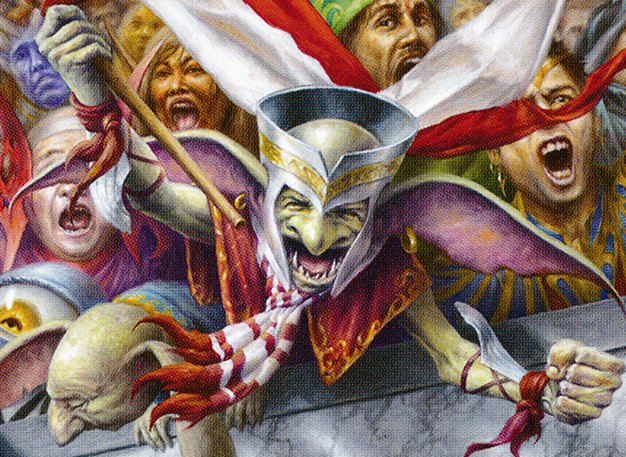Seriously, don’t take this too seriously. If you’re new to the podcast or new to me, you might not know that I’m a huge sports nerd, and sports are nerdier than ever now. For the past decade, the top sports leagues in the world have gone through an analytics revolution. From baseball, to basketball, to soccer (or football for the non-americans) sports are now about the probabilities and the percentages. Teams are reliant on professionals to crunch the numbers in order to find the best plays, players, and strategies to win. I’m far from a professional, the exact opposite in fact, but that’s not going to stop me from plugging some numbers into a spread sheet and playing pretend. Actual experts look away because this is my extremely amateur data review of the first four rounds of the 2023 Design League. Let’s find out how to design the perfect card to win the remaining qualifiers.
Methodology
If you can even call it that…
Design League Moderator Redbay has generously provided a breakdown of the Judge Votes from each qualifier round to the members of the Beacon of Creation Discord. These spreadsheets are great for participants looking to improve their designs for next round as they feature feedback from each of the judges — Tim, Redbay, and Kaiyu. The feedback is super informative, and we will be throwing it out the window for this analysis. I don’t know how to quantify those words. The only thing I care about are the numbers, specifically the number of judge votes each submission received. I used this number as my multiplier to created a weighted score to separate the submissions the judges liked from the ones they loved. From there I broke the components of each submission into 14 categories:
Specific Color Identity (white, blue, black, red, green), General Color Identity (multicolor, mono-color, colorless), number of words in the title, Total Mana Value, Art (none, description, traditional, or AI), Type (including super type), Rarity, number of keywords, whether an activated ability, triggered ability, or both were present, number of paragraphs on the card, whether the card had flavor text, Power, and Toughness.
For each Judge Vote a card received, it added a flat score to the applicable categories. So, if a white equipment card received 2 judge votes then it added a score of 2 to white and to artifact along with any other category it fit into. You can see a spreadsheet of this here.
Results
Not to be taken too seriously
Color Identity (Specific)
| White | 16 |
| Blue | 14 |
| Black | 16 |
| Red | 9 |
| Green | 9 |
Based on the Judge Votes, the best design is either white or black, with blue not hurting your chances of winning too severely. However avoid red and green unless you have a top notch design like Platypeople’s Windmill Charge, Craftedlavaistrue’s Titanoth Pup, or Juliet’s Meet Cute these cards were able to buck the trend and garner more than one vote despite being red or green.



Color Identity (General)
| Multicolor | 14 |
| Mono-color | 27 |
| Colorless | 6 |
When it came to how many colors to include in your card, mono-color appears to be the way to go. There’s been a total of 47 judge votes cast and over half of those votes have gone to mono-colored submissions. Design Qualifier two requiring a common card submission may account for the gap between mono-colored and multi-colored designs. However, if you’re deciding between white or black for your card’s color identity, it’s probably better to pick one than make it a multicolored card. Three colorless card were able to snap up votes and two of the three came with power and toughness. Might be best to make sure your colorless submissions are able to attack similar to designs by Wobbles and LudosGD.
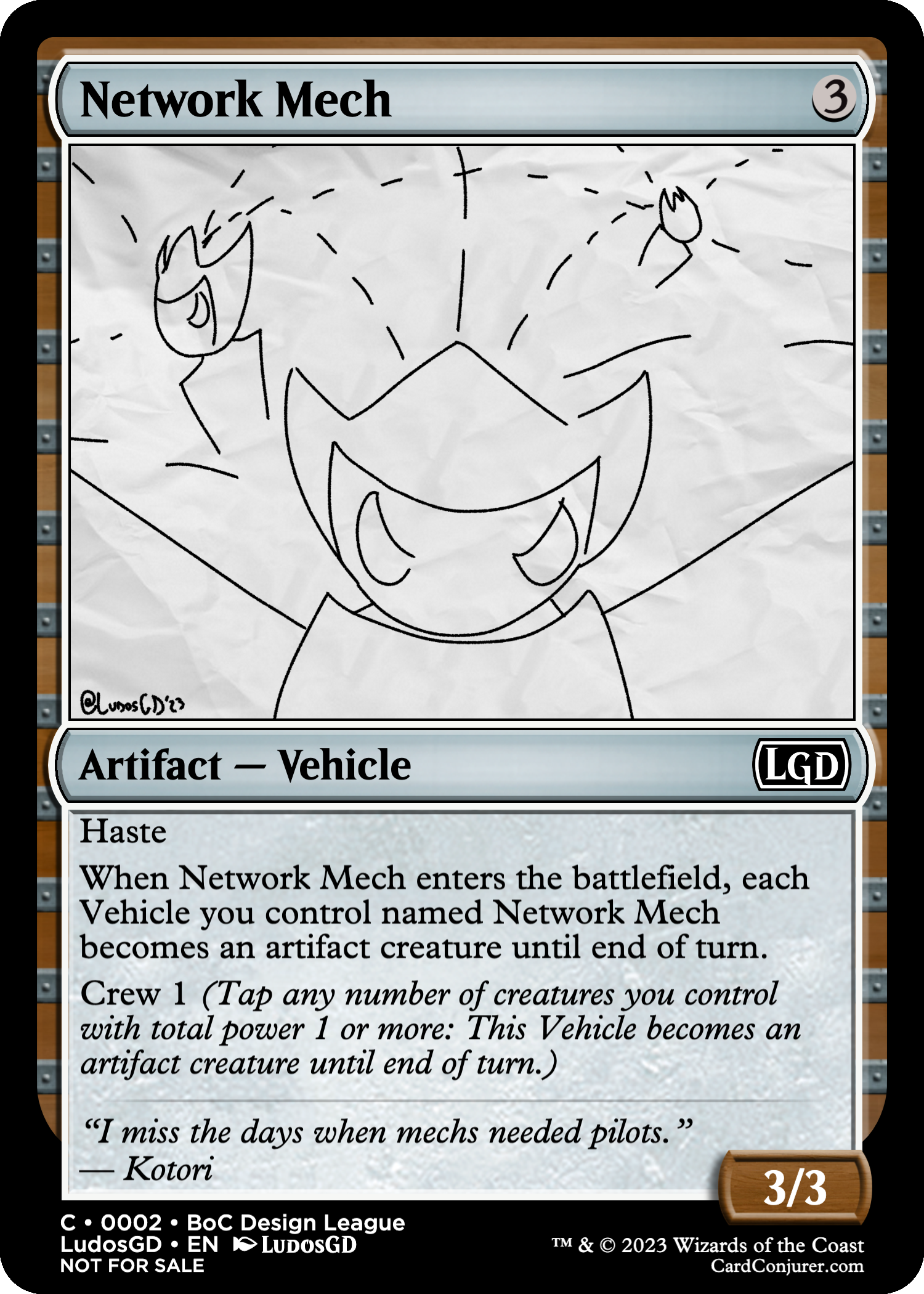

Card Name
| One Word | 5 |
| Two Words | 26 |
| Three Words | 6 |
| Four Words | 9 |
| Five Words | 0 |
| Six Words | 1 |
Having some trouble coming up with a catchy card name? Shorter may be better. Whether it was Noun Verb, Verb Noun, or Adjective Noun, the staple two word card title seemed to be the way to go. Cards that did go above two words in the title tended to be legendary creatures with LudosGD creating the longest card name to receive points at six words.
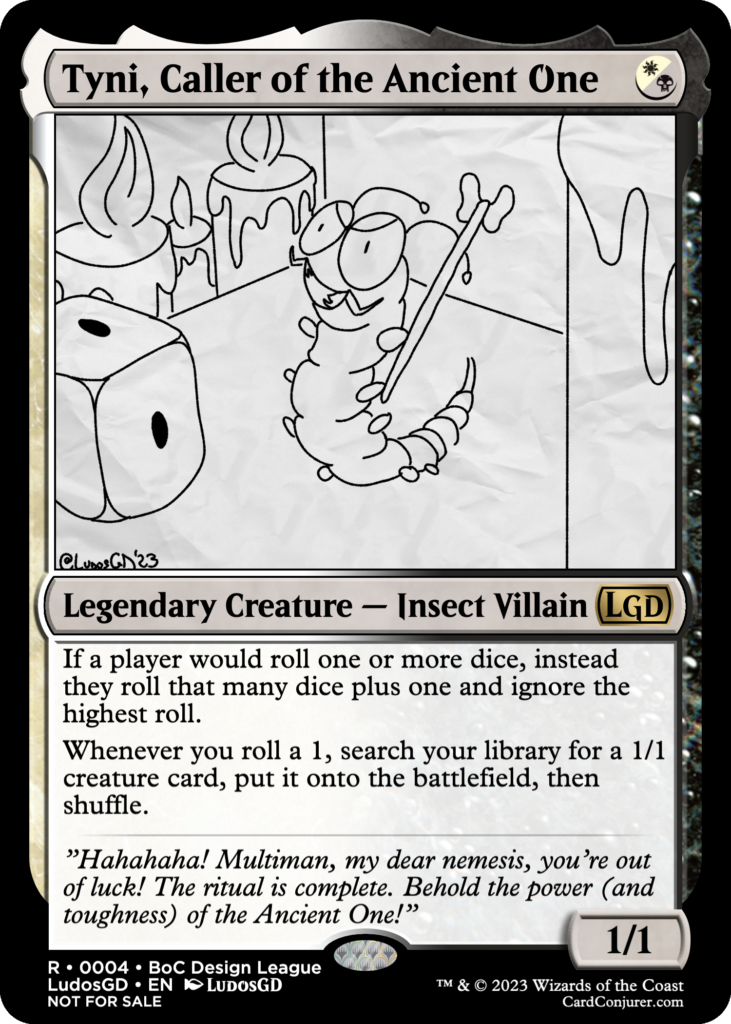
Mana Value
| 0 | 1 |
| 1 | 4 |
| 2 | 16 |
| 3 | 8 |
| 4 | 10 |
| 5 | 5 |
| 6 | 3 |
| 7+ | 0 |
Mana Value can be one of the trickiest parts about designing a card. Too low and you risk having something overpowered. Too high, and your card might never see the battlefield. In the Design League mana values 2-4 have been the sweet spot with two mana value spells getting the edge. Monowhiteborder was able to get a point submitting zero mana value land, and Craftedlavaistrue’s Titanoth Pup grabbed the only three points for cards costed over five.

Art
| No Art | 18 |
| Art | 12 |
| Description Only | 15 |
| AI Art | 2 |
Finding that perfect piece of art can be tricky, but according to the first 4 weeks of the Design League it might be okay if you can’t find it. While some form of art is still more likely to garner you a vote, submission with no nod to art at all are still holding their own. Platypeople has racked up huge number of votes without using art and Perryk snagged three points for their Naban design.

Card Type
| Creature | 30 |
| Artifact | 8 |
| Enchantment | 2 |
| Instant | 2 |
| Sorcery | 6 |
| Land | 1 |
| Legendary | 16 |
Creatures have lead the way when it comes to card types with artifacts in a very distant second. Of the votes gathered by creatures, half of those votes have gone to legendary creatures. If you’re looking to design a non-permanent spell it might be best to balance it as a sorcery as those have earned three times as many points as instants. Larcent’s Miseducate and Grrrbear’s Nothin’ Up My Sleeve are the only instants to grab a point so far.
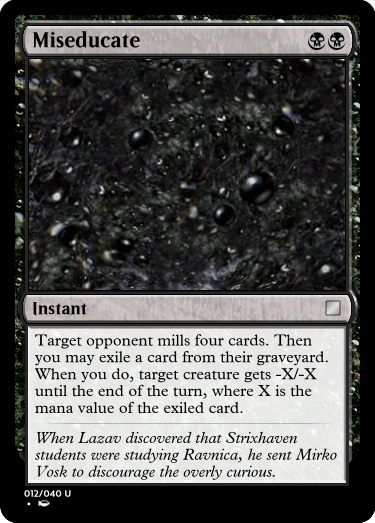

Rarity
| Common | 15 |
| Uncommon | 8 |
| Rarity | 12 |
| Mythic Rare | 2 |
Common edges out Rare for the top spot in the rarity category and that’s despite having a whole challenge dedicated to commons. I expect rare to take the top spot after Qualifier 5. Our first qualifier, Northern Gun, is the only person to take points after designing a Mythic Rare.
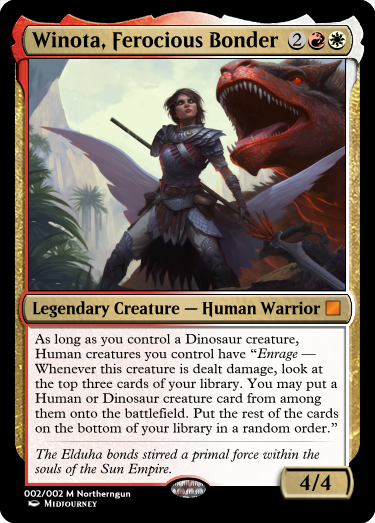
Keywords
| 0 Keywords | 29 |
| 1 Keyword | 7 |
| 2 Keywords | 6 |
| 3 Keywords | 2 |
We are finally to the text box of the card and if you’re first line is a keyword, you might be hurting your chances of winning. Well over half of the Judge Votes went to cards that didn’t feature a single keyword with 1 or 2 on a card being about equivalent. Platypeople was the only designer to get points after adding more than two key words to a card. Their Sidisi design featured three — Delve, Menace, and Deathtouch.

Activated/Triggered Abilities
| Activated Abilities | 13 |
| No Activated Abilities | 34 |
| Triggered Abilities | 27 |
| No Triggered Abilities | 20 |
When it comes to activated and triggered abilities, it’s more important to have a trigger on your card. Whether it’s at the end step, when it enters the battlefield, or when you do something cards with a triggered ability outscored those with an activated, but neither seem to be a deal breaker when it comes to collecting Judge Votes.
Flavor Text
| Yes | 19 |
| No | 28 |
Flavor text is often the cherry on top of a good card, but perhaps that cherry isn’t quite as important as what’s underneath. Submissions without flavor text earned a slight edge in total Judge Votes. When it comes to perfecting the text box, rules text is king.
Power
| 0 | 0 |
| 1 | 4 |
| 2 | 11 |
| 3 | 7 |
| 4 | 3 |
| 5 | 7 |
| 6 | 0 |
| 7+ | 1 |
Toughness
| 0 | 0 |
| 1 | 8 |
| 2 | 5 |
| 3 | 7 |
| 4 | 6 |
| 5 | 6 |
| 6 | 0 |
| 7+ | 1 |
When it comes to crafting the perfect power and toughness (for cards that need them) 2/1 is the way to go. Generally speaking smaller power and toughness have had the edge so far in the competition with the toughnesses being spread fairly evenly while 2 power has a clear edge so far. KuyashiiPlays got points when they went big earning a vote for their 8/8 Omnath design.

The “Perfect” Design
After running the numbers, it was time to put together the perfect card. With all this information gathered, I realized I didn’t even need to be the one to design it. I combined the data I gathered with the prompt for Qualifier 5 and fired up Chatgpt. I provided it the following prompt:
Design a magic the gathering card. I want the magic card to be a white or black mono colored card, with a two word title. The card should be a two mana value creature with no art. I want the card to be a rare with no activated abilities and at least one triggered ability. The rules text should be one paragraph and it should have one of the following abilities: echo, fateful hour, formidable, inspired, miracle, soulbond, suspend, tribute, or vanishing. Finally I want the card to have no flavor text and have power 2 and toughness 1.
After some back and forth where it would give me a design and I would ask it to adjust some aspects, it came back with this:
Eternal Oathsworn BB
If you’d like to see my full conversation with ChatGPT you can find that here.
Creature – Vampire (R)
Inspired – Whenever Eternal Oathsworn becomes untapped, if you control a creature with a +1/+1 counter on it, you may pay {B}. If you do, create a 1/1 black Vampire creature token with lifelink.
Whenever a creature you control with a +1/+1 counter on it dies, you may pay {W}. If you do, return that creature card to the battlefield tapped under your control at the beginning of the next end step
2/1
There it is, the perfect Design League Design based on the Judge Votes from Qualifiers 1-4. Lets check in with one of the Design League judges, Redbay, to see how this might do if it was submitted:
I don’t think ChatGPT would get a single vote from the judges, despite having a robust database of cards and access to perfect data from our previous Design League challenges. Eternal Oathsworn has several issues:
Inspired tended to be a difficult hoop to jump through in the first place– tacking on another thing to check for with +1/+1 counters AND a mana gate is two bridges too far. That’s not even mentioning that the 2/1 body is a serious detriment to getting this card tapped, as it’s very unlikely to survive a combat step.
The second clause has some novelty, but mana gate + etb tapped + delayed trigger makes it more covoluted than it needs to be and sours the mechanic. This card is doing something interesting for a base Black +1/+1 counters deck but the execution is off across the board.
Looks like another point for Human designers over AI.
Redbay, Design League Organizer
Alright, I can’t say I’m terribly shocked. While, this has been a fun way to take a look at some of the top submissions from the first four rounds of the Design League, there are some obvious issues.
First, sample size, there just aren’t enough actual data points to generate any reasonable conclusions about the submissions from the Design League. Even by the end of the this season, we likely won’t have a good enough sample size to get an accurate assessment of what makes a winning design by the numbers. Also, since each qualifier has its own requirements, the data is intrinsically bias in some areas. Qualifier 1 pushed designers to use named characters which incentivized Legendary Creature designs while Qualifier 2 required each designer to produce a common thereby skewing the rarities that way.
The second issue is with the methodology itself. While breaking down each of the elements of a card into their own category and assigning a weighted score did give me something to work with it’s not really an effective way to analyze the submissions. Each element of the card is interconnected to one and other and a good design will weave the elements of the card to create a unified design. It also failed to account for the submission that weren’t awarded votes. This is important because if white cards were submitted twice as often as green cards it would make since that they have more votes in general.
Finally, the data doesn’t actualize analyze the rules text which is arguably the most important part of these designs. Text based analysis can absolutely be employed to analyze designs and determine what makes one superior to the other, but I simply don’t have that knowledge. Talking to a friend in the data science feel they explained machine learning can be used to look at the actual text of the card to create a model that would demonstrate how likely a design would be to receive Judge Votes. It would simply require a lot more work and a lot more know how.
I had a lot of fun putting these bad analytics together and I hope you had some fun and maybe got a laugh reading about them. If you’re looking to take part in the Design League you can head over to the Beacon of Creation discord. There’s still two more qualifier rounds left to claim your spot in the eight person tournament.
